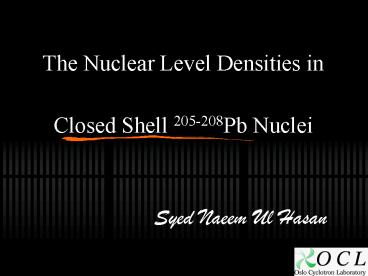The Nuclear Level Densities in Closed Shell 205208Pb Nuclei - PowerPoint PPT Presentation
1 / 26
Title:
The Nuclear Level Densities in Closed Shell 205208Pb Nuclei
Description:
... in both particle- coincidence & particle singles mode by the CACTUS multi-detector array. ... A, B, are free parameters. A. Schiller et al./ Nucl. Instr. ... – PowerPoint PPT presentation
Number of Views:178
Avg rating:3.0/5.0
Title: The Nuclear Level Densities in Closed Shell 205208Pb Nuclei
1
The Nuclear Level Densities in Closed Shell
205-208Pb Nuclei
Syed Naeem Ul Hasan
2
Introduction
- Nuclear level density Bethe Fermi gas model in
1936. For many years, measurements of NLD have
been interpreted in the framework of an infinite
Fermi-gas model. - Gil. Cam. CTF, BSFG were later proposed
accounting shell effects etc. - Shell Model Monte Carlo (SMMC)
3
- Experimental NLD,
- Counting of neutron (proton) resonances
- Discrete levels counting
- Evaporation spectra
- OSLO METHOD
- Method has successfully been proven for a No. of
nuclei. - However in cases where statistical properties are
less favorable the method foundation is more
doubtful. - A test at the lighter nuclei region has been made
already for 27,28Si. - The limit of applicability of method on closed
shell nuclei was also required.
4
Experimental details
- MC-35 cyclotron at OCL,
- 38 MeV 3He beam bombarded on 206Pb and 208Pb
targets having thickness of 4.707 and 1.4
mg/cm2. - Following reactions were studied,
- 206Pb(3He, 3He)206Pb
- 206Pb(3He, ?)205Pb
- 208Pb(3He, 3He)208Pb
- 208Pb(3He, ?)207Pb
- The particle-? coincidences were recorded
while the experiment ran for 2-3 weeks.
5
Oslo Cyclotron Lab
CACTUS
Concrete wall
http//www.physics..no/ocl/intro/
6
- Detector Arrangement
- The charged ejectiles ----gt 8 collimated Si at
45o to the beam. - The ?-rays detection -----gt CACTUS 28 NaI(Tl)
5x5 - detection ? 15 of 4p.
- Particles ?-rays are produced in rxns are
measured in both particle-? coincidence
particle singles mode by the CACTUS
multi-detector array.
7
Data Analysis
Unfolding of coincidence spectra
Raw Data
Particle Spectra Calibration
?-spectra calibration and alignment
Extracting Primary- ? spectra
Data Reduction
Particle - ? coincidences
thickness spectrum Gating on particles
8
Coincidence Spectra
9
Unfolding
- Detector response of 28 NaI detectors are
determined 11 energies and interpolation is made
for intermediate ?-energies. - Folding iteration method is used
- Unfolded spectrum is starting point, such that,
f R u. - First trial fn as, uo r
- First folded spectrum, fo R uo
- Next trial fn, u1 uo (r - fo)
- Generally, ui1 ui (r - fi)
- Iteration continues until fi r
- Fluctuations in folded spectra Compton
background are subtracted.
10
Test of method
11
Primary ?-matrix
- Assumption
- The ?-decay pattern from any Ex is independent
of the population mechanism - The nucleus seems to be an CN like
system prior to ?-emission. - Method The f.g. ?-spectrum of the highest Ex is
estimated by, - f1 f.g. ?-spectrum of highest Ex bin.
- g weighted sum of all spectra.
- wi prob. of decay from bin 1 - i.
- ni ?i / ?j
12
(No Transcript)
13
(No Transcript)
14
(No Transcript)
15
- Multiplicity Normalization
- Algorithm
- Apply a trial fn wi
- Deducing hi fi - ? g
- Transforming hi to wji (i.e. Unfold h, make h
having same energy calibration as wi, normalize
the area of h to 1). - If wji (new) wji (old) then the calculated hi
would be the Primary-? function for the level Ei,
else proceed with (2)
Some experimental conditions can introduce severe
systematic errors, like pile-up effects,
isomers etc.
16
Testing of an Experimental spectrum
Ex 4.5-5.5 MeV.
17
Extraction of NLD GSF
- Brink-Axel Hypothesis
- Transforming
- A, B, ? are free parameters.
- A. Schiller et al./ Nucl. Instr. Methods in
Physics Research A 447 (2000) 498-511
fEdiff
?Ef
18
- Gamma transition probability
- Theoretically
- Minimizing
19
Nuclear Level Density
- At low Ex
- comparing the extracted NLD to
- At Bn deducing NLD from resonance spacing data.
- BSFG level density extrapolation
- where a level density parameter,
- U E-E1 and E1 back-shifted parameter,
20
(No Transcript)
21
Experimental NLD
22
Entropy
- ?o is adjusted to give S ln ? 0 close to
ground state band - The ground band properties fullfil the Third law
of dynamics - S(T 0) 0
23
Gamma Strength Function
- The fitting procedure of P(Ei, E?) determines the
energy dependence of T(Ei, E?) . - The fitting of B must be done here.
- Assumptions
- The decay in the continuum E1, M1.
- No of states with ? is equal
- Radiative strength function is,
24
Collaborators
- Magne Guttormsen University of Oslo
- Suniva Siem University of Oslo
- Ann Cecilie University of Oslo
- Rositsa Chankova University of Oslo
- A. Voinov Ohio university, OH, USA
- Andreas Schiller MSU, USA
- Tom Lønnroth Åbo Akademi, Finnland
- Jon Rekstad University of Oslo
- Finn Ingebretsen University of Oslo
25
- Thank You
26
(No Transcript)




























